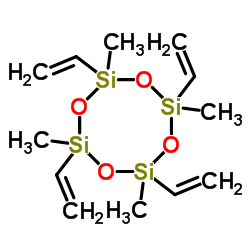2,4,6,8-Tetramethyl-2,4,6,8-tetravinyl-1,3,5,7,2,4,6,8-tetraoxatetrasilocane

2,4,6,8-Tetramethyl-2,4,6,8-tetravinyl-1,3,5,7,2,4,6,8-tetraoxatetrasilocane structure
|
Common Name | 2,4,6,8-Tetramethyl-2,4,6,8-tetravinyl-1,3,5,7,2,4,6,8-tetraoxatetrasilocane | ||
|---|---|---|---|---|
| CAS Number | 2554-06-5 | Molecular Weight | 344.659 | |
| Density | 1.0±0.1 g/cm3 | Boiling Point | 247.8±23.0 °C at 760 mmHg | |
| Molecular Formula | C12H24O4Si4 | Melting Point | -44ºC | |
| MSDS | Chinese USA | Flash Point | 94.3±23.0 °C | |
| Symbol |

GHS07 |
Signal Word | Warning | |
|
Ultrafast cooling reveals microsecond-scale biomolecular dynamics.
Nat. Commun. 5 , 5737, (2014) The temperature-jump technique, in which the sample is rapidly heated by a powerful laser pulse, has been widely used to probe the fast dynamics of folding of proteins and nucleic acids. However, the existing temperature-jump setups tend to involve sophistica... |
|
|
Vinylation of aryl bromides using an inexpensive vinylpolysiloxane.
Org. Lett. 8 , 63, (2006) [reaction: see text] A mild and general method for the palladium-catalyzed vinylation of aryl bromides has been developed. The use of tetrabutylammonium fluoride (TBAF) as the activator and an inexpensive and nontoxic vinyl donor, 1,3,5,7-tetramethyl-1,3,5,7-... |
|
|
Fracture-based fabrication of normally closed, adjustable, and fully reversible microscale fluidic channels.
Small 10(19) , 4020-9, (2014) Adjustable fluidic structures play an important role in microfluidic systems. Fracture of multilayered materials under applied tension has been previously demonstrated as a convenient, simple, and inexpensive approach to fabricate nanoscale adjustable structu... |
|
|
Cracking-assisted photolithography for mixed-scale patterning and nanofluidic applications.
Nat. Commun. 6 , 6247, (2015) Cracks are observed in many environments, including walls, dried wood and even the Earth's crust, and are often thought of as an unavoidable, unwanted phenomenon. Recent research advances have demonstrated the the ability to use cracks to produce various micr... |
|
|
The Influence of a Biologically Relevant Substratum Topography on Human Aortic and Umbilical Vein Endothelial Cells
Biophys. J. 102 , 1224-1233
|